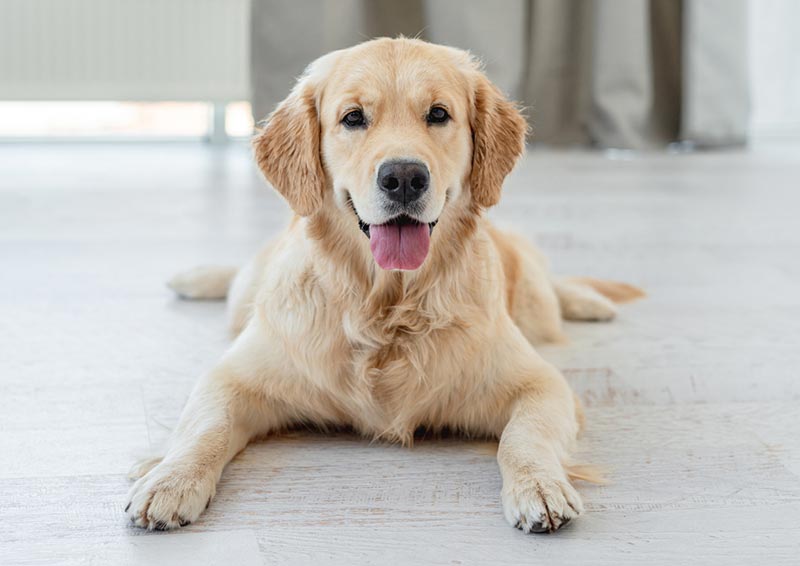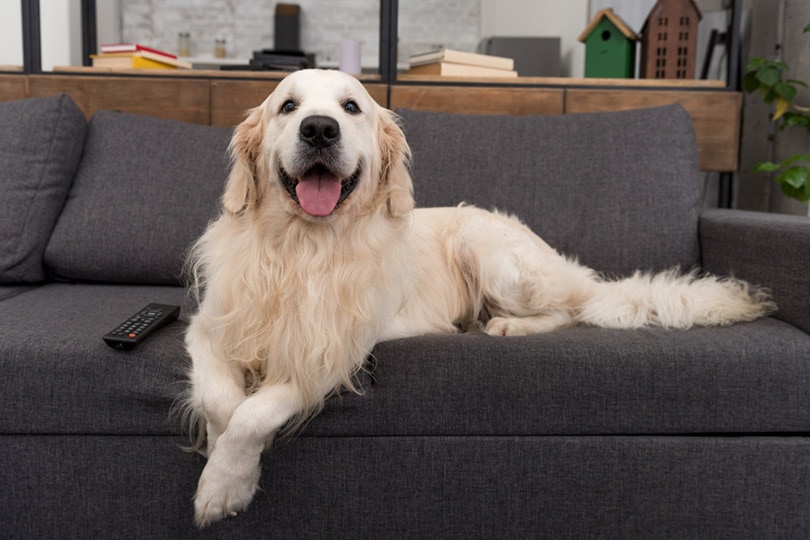In this article
You won’t see a dog waving a fan in its face to cool off or putting on a pair of fuzzy slippers to keep their feet warm (although that would be adorable). The reality is that dogs don’t regulate body temperature like humans. They also don’t have as much control over the temperature as we do, so it’s up to us to maintain the room’s temperature so our dogs feel comfortable. Generally, dogs like it when the temperature is between 68–73 degrees Fahrenheit.
Achieving the ideal room temperature isn’t always easy. It depends on your location and whether or not your dog has medical concerns. But with the help of air conditioning, heat, and a few simple adjustments, you can ensure your dog feels comfortable all year round.
In this guide, we’re sharing the ideal temperature range for a dog and how you can keep your dog feeling serene, even if you can’t reach that perfect number.

Normal Room Temperature for Dogs
Dogs do best in an environment between 68–73 degrees Fahrenheit. But there isn’t an ideal number for every dog since dogs come in different sizes and breeds. Depending on your dog and your location, you could go as high as 78 degrees Fahrenheit in your house and as low as 60 degrees Fahrenheit.
For example, if you live in frigid Alaska, you may want to shoot for a warmer temperature. If you live in the blistering heat of Arizona, you may want to keep the house cool, around 68 degrees. Some variance is okay, but we don’t recommend dropping below the 60-degree range or going above 80 degrees Fahrenheit, especially when leaving the house for a few hours.

Why Is the Ideal Room Temperature Important?
It may seem unnecessary to think about the ideal room temperature for your dog. It’s not like your dog has an enclosure like a fish or snake, so why does it matter?
Like people, the room temperature can affect your dog’s mood, physical activity, and overall comfort. This is especially true for puppies and seniors or dogs with medical concerns.
Does this mean you have to wait on your dog hand and foot? Nope. Dogs are usually okay with mild temperature variations. So, it’s less about you worrying that Rufus might ask to speak to the manager and more that it’s simply a good idea to remember your pet’s comfort during the most brutal weather changes of the year.

How Do I Know if My Dog Is Too Hot?
Unlike humans, dogs don’t sweat through their coats because the fur is insulating. They have sweat glands in their paws, but this doesn’t do much to keep them cool. Instead, dogs pant.
We all know what panting is. It’s when you can’t hear your TV because your dog is breathing too loud. But this is just what dogs do, to try and expel excess body heat.
If they didn’t pant, dogs would overheat and suffer heat stroke. This is why dogs with breathing difficulties, like bully breeds, can struggle to regulate their own body temperature in extreme temperatures.
- Drooling
- Muscle tremors
- Dizziness
- Vomiting
- Change in mentation
A fever is the most significant indicator your dog is too hot. The ideal temperature for a dog is 101.5 degrees Fahrenheit. Anything above 104 degrees is dangerous. But if your dog is just panting, offer some water and a cool place to rest. Generally, that is enough.
If you are still concerned about the health of your pet after making these changes, seek veterinary advice for the best course of action.
How Do I Know if My Dog Is Too Cold?
When in cold weather, dogs breathe in and out of their noses to stay warm so as not to lose body heat. A dog’s body temperature shouldn’t drop below 98–99 degrees Fahrenheit; otherwise, hypothermia kicks in.
- Muscle stiffness
- Shivering
- Lethargy
- Pale gums
- Confusion
- Cool body surfaces
All these signs are because the body sends blood flow away from the limbs and toward the essential organs like the heart and brain. However, don’t panic if your dog is just shivering. Warm your dog gradually with a blanket and offer something warm to eat near a heat source. Just don’t place your dog on a heating pad. Otherwise, you might risk burning your dog.

How to Improve Your Dog’s Comfort in Summer
You can do other things for your dog in the summer heat to keep your pooch cool as a cucumber. Here are our favorite tips:
1. Provide a Water Fountain
Providing multiple water sources is vital since animals are likely to drink more water from nearby sources. But another way to encourage more water consumption is through pet water fountains. Cats and dogs are attracted to running water, so this is an excellent option for your dog during the peak of summer.

2. Fans Are Okay, But…
Fans are great for limiting humidity and maintaining airflow. But as we mentioned earlier, dogs don’t sweat as humans do. Dogs only sweat through their feet, so fans don’t do much for cooling dogs off as we would expect. That doesn’t mean that fans are useless,
3. Be Mindful of the Humidity
It’s difficult for a dog to cool off when it’s humid outside. The excess moisture in the air doesn’t help eliminate the extra body heat when dogs pant, so be mindful of humidity levels in your area. You may even want to get a dehumidifier if you live in an area with humidity above 60%, but this isn’t necessary. You can always adjust your AC to a lower setting.

How to Improve Your Dog’s Comfort in Winter
For locations with cold climates, let’s go over some ways to keep your dog warm and cozy.
1. Lay Down Some Rugs
Houses with tile and wood flooring can feel cold and drafty. Give your dog a warm, soft place to relax by laying down some rugs. Rugs are especially handy at providing a non-slip surface for older dogs with arthritis that can’t jump on couches very well.

2. Offer Warm Meals
We all love warm soup in cold weather for a reason. If your dog is cold, warm some wet food or offer some boiled chicken and rice to go with their kibble.
3. Get Your Dog a Sweater
Short-haired dogs could use some extra layering with a cute dog sweater. You can find dog sweaters in multiple sizes, and they’re easy to pull on and off. Aside from looking charming, dog sweaters will help short-haired dogs maintain body heat and protect their fur and skin from the harsh winter wind. You won’t have to turn your heat up as high either.
4. Keep Your Dog’s Bed Away From the Window
Sometimes, we forget that windows can be drafty. Even high-quality windows are cold to be near. If your dog’s bed is near a window, move it someplace away from the shivering window pane so they can warm themself better.

Frequently Asked Questions (FAQ)
Should I Leave the Heat on for My Dog?
In the winter, you should leave the heat on if you’re planning on being away from the house longer than a few hours. How high you set the heat is up to you and your dog. If your dog is old, short-haired, or has any medical issues, it might be a good idea to leave the heat between 75–78 degrees.
Remember, you can always lay down blankets and rugs or put a sweater on your dog if you can’t afford to turn the heat up. Just don’t leave any radiators or heating pads on when you leave the house.

What Temperature Indoors Is Too Hot?
Purdue University recommends not going above 84 degrees Fahrenheit for more than 4 hours daily. Even then, that’s pretty hot for a dog. We recommend not going above 78 degrees Fahrenheit for safety measures.

Conclusion
The ideal room temperature for a dog rests between 68–73 degrees Fahrenheit. But as you can see, several factors can determine the perfect temperature for your house. The best thing you can do is to pay attention to your dog and make adjustments as you go. If you’re uncomfortable, then it’s possible your dog feels the same way.
Featured Image Credit: LightField Studios, Shutterstock




















